Epiphone or Fender Acoustic Guitars: Which Are Better Value?
Epiphone and Fender are two of the most popular and reputable companies within the electric guitar community, but how do their acoustic guitars stack up against each other?
Both Epiphone and Fender make a good variety of acoustic guitars, mainly concentrating on entry level to midrange acoustic guitars. At the high end, Epiphone feature high quality classic designs vs Fender exploring new technologies with their electric-inspired Acoustasonic range. Epiphone offer great value beginner and midrange guitars.
Even though both companies make some good quality guitars, not every model is suited to every player, and you really need to look closer at some models in your price range to find the best value option for you.
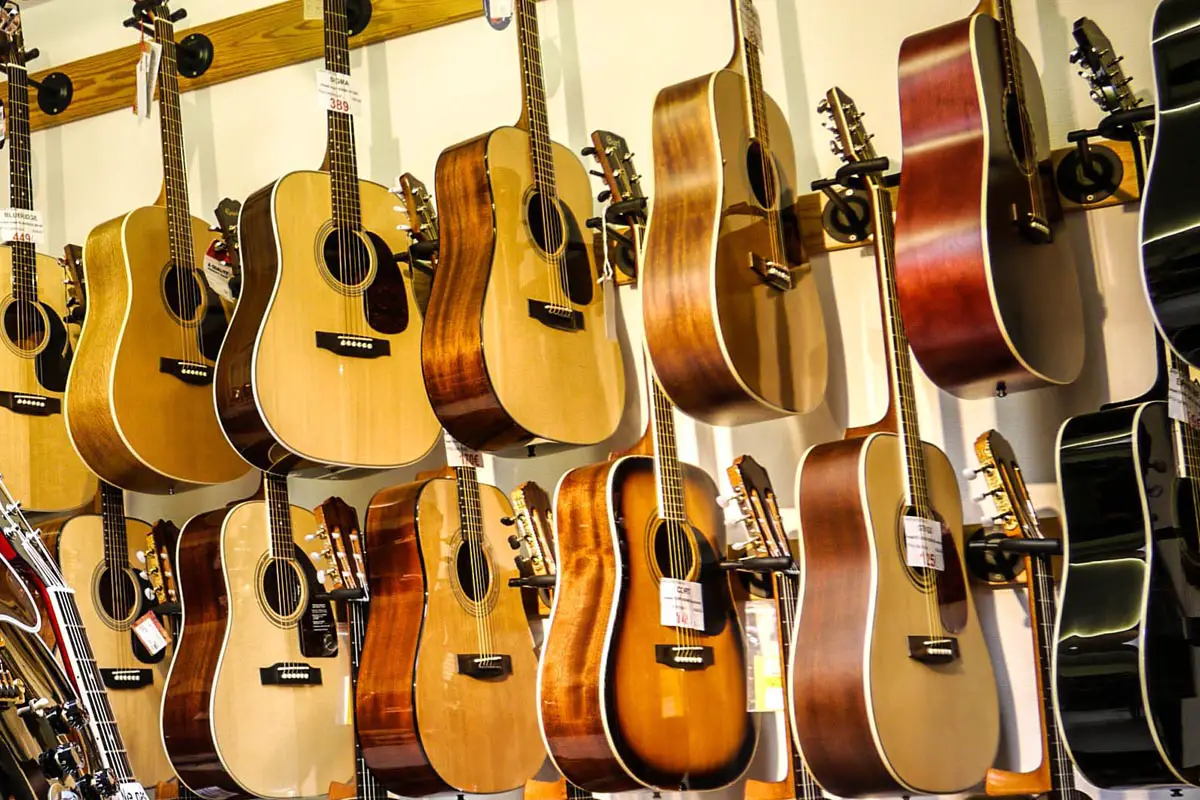
Epiphone vs Fender Acoustic Guitars – What Players Think
Most guitarists know that Gibson owns Epiphone, and Gibson is well-known for its acoustic guitars. Even better, most of Epiphone’s acoustics are “Inspired by Gibson,“ which gives Epiphone a slight edge simply on their name alone.
Epiphone predominantly manufactures budget guitars, which are often defined by guitarists as underrated. Compared to other budget-friendly manufacturers, Epiphone has a reputation for producing quality products.
Because of Fender’s reputation in the electric realm, it shouldn’t come as a surprise that the number one selling feature for their acoustic guitars just so happens to be their guitar necks. They’re designed with that same slender electric feel making them very comfortable and easy to handle.
Most players agree that Epiphone make much nicer sounding budget guitars than Fender, with many guitarists commenting that cheap Fender acoustics sound awful, even on Fender fan forums.
That being said, there are still many beginners who have been more than happy with their starter Fender acoustic, and it often comes down to how developed your musical ear is.
Which Brand Has The Best Range of Acoustic Guitars?
While Fender has a decent amount of acoustic guitars to choose from, Epiphone has a slightly better range of basic acoustics, as well as a more affordable range.
Many Epiphone acoustics are beginner copies of popular Gibson models.
However, Fender offers a unique and original genre of Acoustasonics (which is its very own hybrid model), but with a starting price around $1200 they are unaffordable for many players.
Epiphone vs Fender Beginner Acoustic Guitars
Comparing the most popular 20-fret starter guitars by both brands, you’ll see that their physical construction differs very little.
For around $200, the Fender FA-125 is a dreadnought with a laminated spruce top, basswood back and sides, and gloss finish. It has a Nyatoh neck supporting a walnut fingerboard with a 25.3” scale length and die-cast tuning machines.
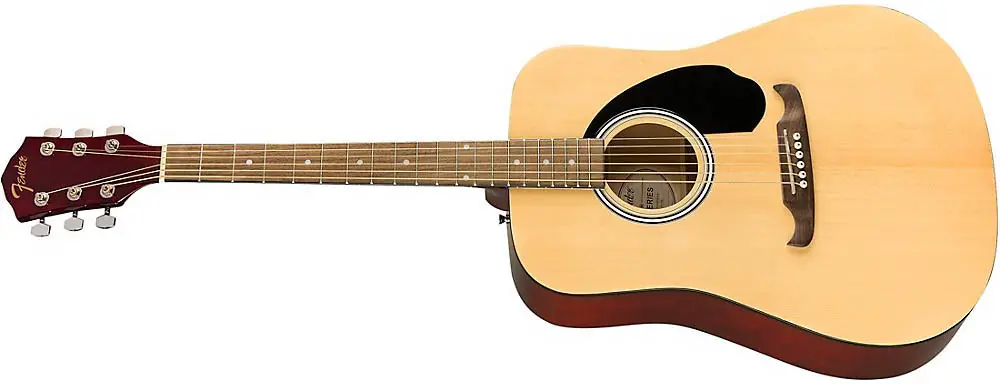
The FA-125 has good sound range that’s very balanced. For a starting guitar, it produces above-average low-end sound with decent projection and an even tone throughout. The neck plays like an electric fretboard making it a good choice for beginners.
The Epiphone DR-100 Songmaker is Epiphone’s most popular and affordable entry-level guitar. Slightly less around $170, this guitar comes in vintage sunburst, natural, or black.
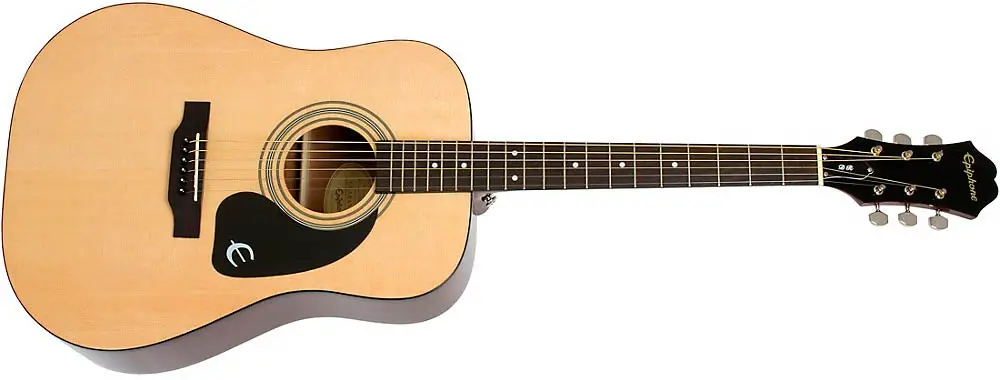
Epiphone uses select spruce top with mahogany back and sides. It also has a comfortable mahogany SlimTaper neck with a rosewood fingerboard and bridge.
The DR-100 has a 25.5” scale length and nickel hardware. Its body features scalloped, wide-X internal bracing for optimal resonance and volume.
Slightly more expensive, but still affordable are the Fender CD60S and the Epiphone PR-150.
Around $215, the Epiphone PR-150 is a classical spruce top dreadnought with mahogany back, sides, and neck. It has a rosewood fretboard with chrome hardware and a 25.5” scale length.
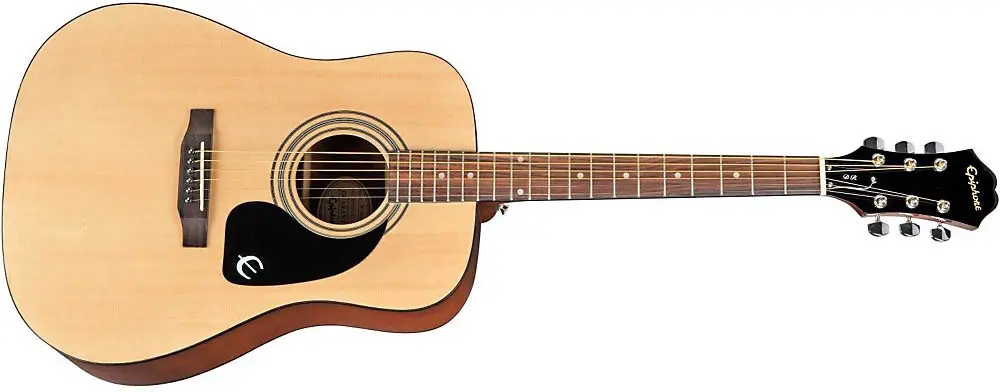
The neck features Epiphone’s C-shape SlimTaper neck instead of their traditional D-neck. This guitar features a full, vibrant, classic sound that’s well balanced with resonant tops and warm lows.
Marginally more costly around $230, the Fender CD60S is a classical dreadnought design with solid spruce top, mahogany back and sides, and gloss finish.
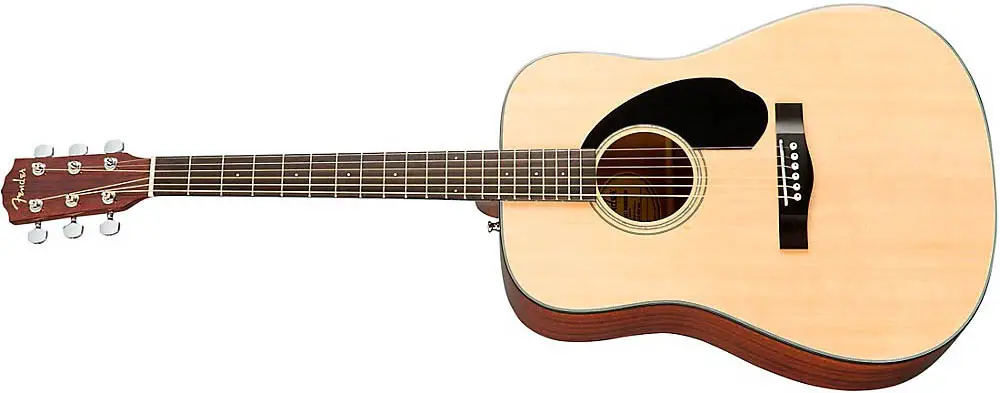
Its mahogany neck features a rosewood fingerboard with rolled edges making it ‘Easy-to-Play.‘ The CD602 has a 25.3” scale length and chrome tuning machines.
This guitar plays well above its performance expectation with solid mids and highs, but soft, distinctive lows. It has a full-bodied, crisp, and vibrant tone with plenty of projection.
Feature & Price Comparison
When comparing these four starter guitars the materials are almost identical except the FA-125 uses basswood, Nyatoh, and walnut, and the DR-100 uses mahogany and rosewood.
Yet Fender is slightly more expensive.
It’s not that one quality of wood is better than the other, but it does impact the sound.
Basswood resonates softer and weaker, with brighter mids and trebs. However, their midranges are proportionately stronger. The mahogany provides warmer tones with more stability and resonance.
Which is Easiest To Play: Epiphone or Fender?
Playability is really dependent on personal preference. Both offer slim C-Neck profiles with the Fenders having slightly shorter scale lengths giving them a small advantage to smaller individuals.
Which Beginner Acoustic Guitar Has the Best Sound Quality?
Almost every starter guitar uses laminated woods because they’re more cost-effective, but the result is mediocre sound, particularly in the bass. One sound isn’t better than the other, just different based on tonal woods.
Spruce woods magnify top notes, and mahogany gives warmth to low notes. Basswood gives a softer, weaker low range but has more stability and resonance. So choosing the right one for you will depend on what type of sound you favor.
The basswood body of the Fender makes the sound a bit flat and 1-dimensional, and so Epiphone with their mahogany body may be a better choice for a slightly richer sound.
Epiphone vs Fender Midrange Acoustic Guitars
Two of the most popular mid-range acoustics include the Fender Malibu and the Epiphone Hummingbird.
At approximately $450, the Fender Malibu has a solid spruce top with mahogany back and sides and polyurethane gloss. Its mahogany C-shaped neck has a Satin finish, laurel fingerboard and bridge, a 24.1” scale length, and nickel hardware.
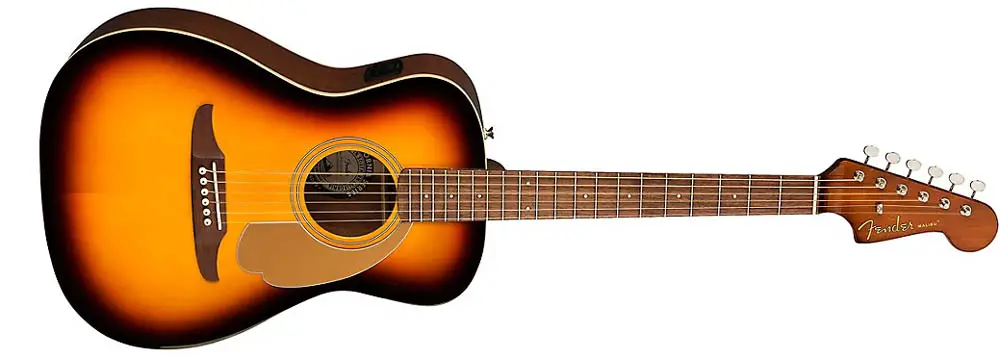
With its Fishman preamp system, the Malibu is known for its superior resonance and greater sustain. It has good audio with well-balanced and articulate sounds that display solid, vibrant tones.
For the same price, the Epiphone Hummingbird acoustic offers a solid spruce top, mahogany body and neck, and rosewood fretboard. The Hummingbird sports the traditional Gibson D-neck profile with nickel hardware and has a scale length of 24.75”.
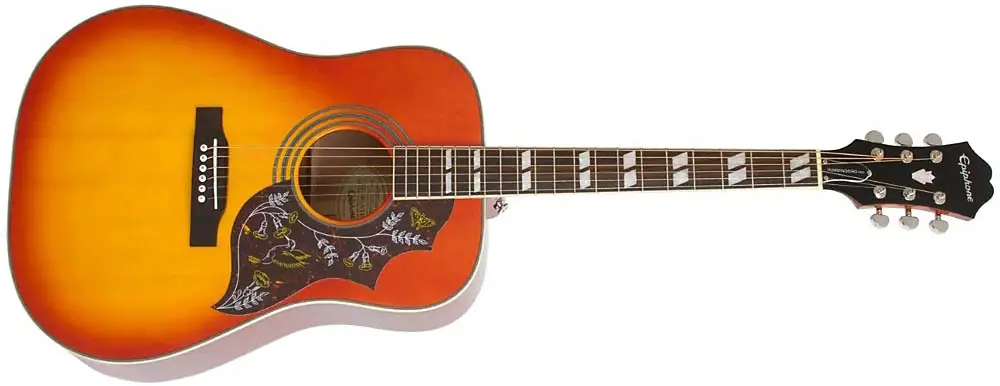
The Hummingbird displays a Shadow NanoFlex pickup system under the saddle for a balanced tone with smooth action and intonation.
Feature & Price Comparison
The only significant difference between these two guitars is Fender’s C-neck, laurel fretboard versus Epiphone’s D-neck, rosewood fretboard, and the sound systems. The Malibu is slightly smaller with a 24.1” scale length.
Which Has the Best Sound Quality?
Being almost identical in construction, both are very similar providing nice balanced tones. The rosewood has a slightly warmer tone than the laurel.
Epiphone vs Fender Higher-Price Acoustic Guitars
On the high end of the spectrum, Fender offers the Newporter Classic against Epiphone’s J-45 EC modeled after the Gibson Montana J-45.
Fender Newporter Classic
Sold for around $830, the Fender California Newporter Classic Acoustic-Electric has a solid spruce top, back, and sides.

Inspired by its iconic electric legacy, it has a Satin-finished, mahogany C-neck with a unique Pau Ferro fingerboard, which is similar to rosewood but lighter and harder. It has a slightly larger scale length of 25.6” with sealed-nickel hardware.
Designed for performing, the Newporter comes with Fisherman Undersaddle piezo pick-up and preamp with 3-band equalizer and an upgraded bone nut and saddle. This guitar has balanced tonal characteristics with increased resonance and sustain.
Epiphone J-45 EC
The slightly less expensive Epiphone J-45 EC can be purchased for around $800.
It has a solid Sitka spruce top that provides a cutaway for accessing upper frets. It also has solid mahogany back, sides, and C-neck with laurel fretboard. The J-45 has a 24.72” scale length and nickel hardware.
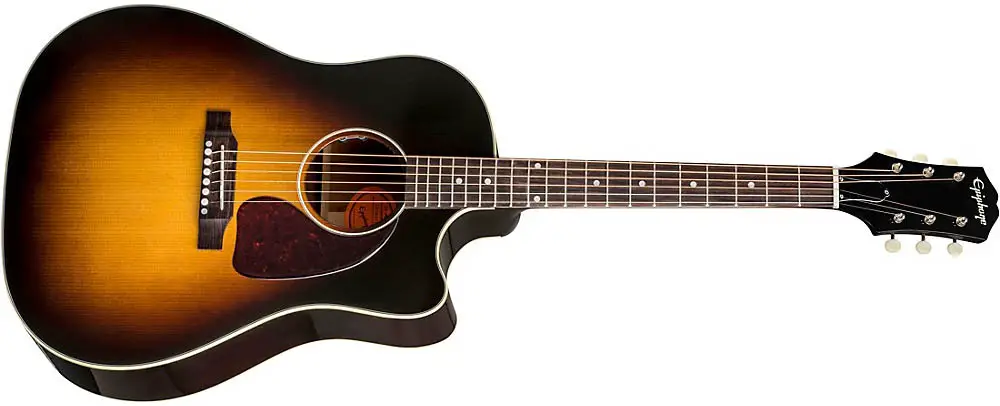
The J-45 comes with Fishman Sonicore under-saddle pick-up and Presys II preamp with volume tone controls. It has a robust bass with rugged mids for an overall warm tone and good sound projection with plenty of punch.
Are Epiphone Acoustic Guitars Better Value Than Fender?
Entry Level Guitars
When comparing the Fender FA-125 VS Epiphone DR-100, these sounds are practically identical. Both have spruce tops, giving them plenty of top-end presence, but Epiphone’s mahogany body and neck offer slightly more warmth to the bass notes.
Given the marginally better choice of finishes, the better wood selection, and the greater affordability, Epiphone provides more value in this instance.
When comparing the Epiphone PR-150 to the Fender CD60S, while both utilize spruce tops with mahogany back and sides, the solid top of the Fender CD60S gives it better tone and volume.
Not only do laminate woods not age as well, but they also don’t produce as good of a sound as solid-top guitars. For only $15 more, you get a better quality guitar by simply having the solid spruce top.
Midrange Guitars
Between the Fender Malibu and the Epiphone Hummingbird, it’s an outright tie. There’s no concrete difference between the two models. You’re simply choosing between preferred sound, fretboard, scale length, and pick-up systems.
Upper Midrange Guitars
Placing Fender’s California Newporter and Epiphone’s J-45 side by side, both use solid spruce tops and solid mahogany sides. Epiphone uses Sitka spruce, which produces a different sound, but not necessarily better quality.
Both have mahogany C-necks, but Fender uses a Pau Ferro fretboard for a snappy, sharp tone, whereas Epiphone uses a laurel fretboard for more balanced tones across all frequencies.
The biggest difference between these two guitars is the scale size and the $30 difference in price. Deciding between the Newporter and J-45 comes down to preferred size and sound.
Final Thoughts
When comparing quality and value, there’s not much difference between Fender and Epiphone acoustic guitars.
They use mostly the same materials, and although Fender has a bit more variety with fingerboard woods, Epiphone consistently offers better pricing. You will also find Epiphone produce better sounding guitars at the entry level than Fender, and that more expensive Fender acoustic guitars are generally better value than their cheaper models.
It comes down to your preferred look, feel, and sound. You’re likely to strongly prefer one over the other, and the best way to know is to play a few before deciding.




